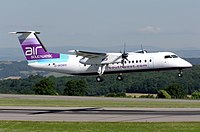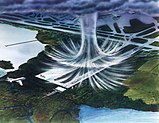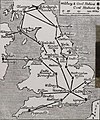| Main page | Categories & Main topics |
|
Tasks and Projects |
The Aviation Portal

Aviation includes the activities surrounding mechanical flight and the aircraft industry. Aircraft includes fixed-wing and rotary-wing types, morphable wings, wing-less lifting bodies, as well as lighter-than-air craft such as hot air balloons and airships.
Aviation began in the 18th century with the development of the hot air balloon, an apparatus capable of atmospheric displacement through buoyancy. Some of the most significant advancements in aviation technology came with the controlled gliding flying of Otto Lilienthal in 1896; then a large step in significance came with the construction of the first powered airplane by the Wright brothers in the early 1900s. Since that time, aviation has been technologically revolutionized by the introduction of the jet which permitted a major form of transport throughout the world. (Full article...)
Selected article
Wind shear itself is a microscale meteorological phenomenon occurring over a very small distance, but it can be associated with mesoscale or synoptic scale weather features such as squall lines and cold fronts. It is commonly observed near microbursts and downbursts caused by thunderstorms, weather fronts, areas of locally higher low level winds referred to as low level jets, near mountains, radiation inversions that occur due to clear skies and calm winds, buildings, wind turbines, and sailboats. Wind shear has a significant effect during take-off and landing of aircraft due to their effects on steering of the aircraft, and was a significant cause of aircraft accidents involving large loss of life within the United States.
Sound movement through the atmosphere is affected by wind shear, which can bend the wave front, causing sounds to be heard where they normally would not, or vice versa. Strong vertical wind shear within the troposphere also inhibits tropical cyclone development, but helps to organize individual thunderstorms into living longer life cycles which can then produce severe weather. The thermal wind concept explains with how differences in wind speed with height are dependent on horizontal temperature differences, and explains the existence of the jet stream. (Full article...)
Selected image
Did you know
...that the mysterious objects known as Black Triangles may actually be hybrid airships? ...that Wing Commander Stanley Goble and Flying Officer Ivor McIntyre, piloting a single-engined seaplane (pictured), became the first men to circumnavigate Australia by air in 1924? ... that Jimmy Doolittle commanded a 22 plane demonstration celebrating the opening of Henderson, Kentucky's Audubon Memorial Bridge in 1932?
General images -
In the news
- May 29: Austrian Airlines cancels Moscow-bound flight after Russia refuses a reroute outside Belarusian airspace
- August 8: Passenger flight crashes upon landing at Calicut airport in India
- June 4: Power firm helicopter strikes cables, crashes near Fairfield, California
- January 29: Former basketball player Kobe Bryant dies in helicopter crash, aged 41
- January 13: Iran admits downing Ukrainian jet, cites 'human error'
- January 10: Fire erupts in parking structure at Sola Airport, Norway
- October 27: US announces restrictions on flying to Cuba
- October 3: World War II era plane crashes in Connecticut, US, killing at least seven
- September 10: Nevada prop plane crash near Las Vegas leaves two dead, three injured
- August 6: French inventor Franky Zapata successfully crosses English Channel on jet-powered hoverboard
Related portals
Associated Wikimedia
The following Wikimedia Foundation sister projects provide more on this subject:
-
Commons
Free media repository -
Wikibooks
Free textbooks and manuals -
Wikidata
Free knowledge base -
Wikinews
Free-content news -
Wikiquote
Collection of quotations -
Wikisource
Free-content library -
Wikiversity
Free learning tools -
Wikivoyage
Free travel guide -
Wiktionary
Dictionary and thesaurus
Selected biography
Erich Alfred "Bubi" Hartmann (19 April 1922 – 20 September 1993), also nicknamed "The Blond Knight of Germany" by friends and "The Black Devil" by his enemies, was a German fighter pilot and still is the highest scoring fighter ace in the history of aerial combat. He scored 352 aerial victories (of which 345 were won against the Soviet Air Force, and 260 of which were fighters) in 1,404 combat missions and engaging in aerial combat 825 times while serving with the Luftwaffe in World War II. During the course of his career Hartmann was forced to crash land his damaged fighter 14 times. This was due to damage received from parts of enemy aircraft he had just shot down, or mechanical failure. Hartmann was never shot down or forced to land due to enemy fire.[1]
Hartmann, a pre-war glider pilot, joined the Luftwaffe in 1940 and completed his fighter pilot training in 1942. He was posted to Jagdgeschwader 52 (JG 52) on the Eastern front and was fortunate to be placed under the supervision of some of the Luftwaffe's most experienced fighter pilots. Under their guidance Hartmann steadily developed his tactics which would earn him the coveted Knight's Cross of the Iron Cross with Oak Leaves, Swords and Diamonds on 25 August 1944 for claiming 301 aerial victories.
He scored his 352nd and last aerial victory on 8 May 1945. He and the remainder of JG 52 surrendered to United States Army forces and were turned over to the Red Army. Convicted of false "War Crimes" and sentenced to 25 years of hard labour, Hartmann would spend 10 years in various Soviet prison camps and gulags until he was released in 1955. In 1956, Hartmann joined the newly established West German Luftwaffe and became the first Geschwaderkommodore of Jagdgeschwader 71 "Richthofen". Hartmann resigned early from the Bundeswehr in 1970, largely due to his opposition of the F-104 Starfighter deployment in the Bundesluftwaffe and the resulting clashes with his superiors over this issue. Erich Hartmann died in 1993.
Selected Aircraft

The de Havilland Canada DHC-8, popularly the Dash 8, is a series of twin-turboprop airliners designed by de Havilland Canada in the early 1980s. They are now made by Bombardier Aerospace which purchased DHC from Boeing in 1992. Since 1996 the aircraft have been known as the Q Series, for "quiet", due to installation of the Active Noise and Vibration Suppression (ANVS) system designed to reduce cabin noise and vibration levels to near those of jet airliners.
Notable features of the Dash 8 design are the large T-tail intended to keep the tail free of propwash during takeoff, a very high aspect ratio wing, the elongated engine nacelles also holding the rearward-folding landing gear, and the pointed nose profile. First flight was in 1983, and the plane entered service in 1984 with NorOntair. Piedmont Airlines (formerly Henson Airlines) was the US launch customer for the Dash 8 in 1984.
The Dash 8 design had better cruise performance than the earlier Dash 7, was less expensive to operate, and more notably, much less expensive to maintain. The Dash 8 had the lowest costs per passenger mile of any feederliner of the era. The only disadvantage compared to the earlier Dash 7 was somewhat higher noise levels, but only in comparison as the Dash 7 was notable in the industry for extremely low noise due to its four very large and slow-turning propellers.
- Length: 107 ft 9 in (32.84 m)
- Wingspan: 93 ft 3 in (32.84 m)
- Height: 27 ft 5 in (8.34 m)
- Powerplant: 2× Pratt & Whitney Canada PW150A turboprops, 5,071 shp (3,781 kW) each
- Cruise speed: 360 knots (414 mph, 667 km/h)
- Maiden Flight: June 20, 1983
Today in Aviation
- 2013 – Solar Impulse aircraft HB-SIA completes the fourth leg of its flight across the continental United States, completing the fourth leg's second segment, a 702-kilometer (436-mile) trip from Cincinnati Municipal Lunken Airport in Cincinnati, Ohio – from which it had departed on 15 June after an 11-hour stopover – to Washington Dulles International Airport in Virginia outside Washington, D.C. The flight takes 14 hours 4 minutes at an average speed of 50 km/h (31 mph) and reaches a maximum altitude of 3,048 meters (10,000 feet). During its stay, the aircraft is placed on temporary display at the National Air and Space Museum's Steven F. Udvar-Hazy Center adjacent to the airport.[2]
- 2011 – The Russian Federation’s flag carrier Aeroflot puts its first Sukhoi Superjet 100 into service.
- 2010 – Trans States Airlines Flight 8050, operated by Embraer ERJ-145 N847HK overran the runway at Ottawa Macdonald-Cartier International Airport and was substantially damaged when the nose gear collapsed.[3]
- 2009 – Two Spanish Air Force McDonnell-Douglas F/A-18 Hornets collide in midair near the Canary Islands, Spain. Both pilots eject safely.
- 1984 – Frontier Airlines pilot Emily Warner and co-pilot Barbara Cook make history by directing the first all-female commercial airline crew, on a flight from Denver to Lexington, Kentucky.
- 1963 – Vostok 6 launched. The pilot is Valentina Tereshkova, first woman cosmonaut.
- 1963 – During the Paris Air Show, first prototype Hawker Siddeley P.1127, XP831, flown by A. W. "Bill" Bedford, is demonstrating low level hovering when a tiny fragment of debris fouls a nozzle actuating motor causing the aircraft to lose height rapidly and crash. Pilot unhurt and the airframe is repaired. Upon retirement, this historic airframe is preserved in the Sir Sydney Camm Memorial Hall at the RAF Museum, Hendon.
- 1961 – Royal Canadian Navy pilot SubLt. I.K. Rassow is killed when he flies his McDonnell F2H-3 Banshee, BuNo 126434 of VF-870, into a rocky knoll during aerobatic practice near Indian Harbour, Nova Scotia.
- 1959 – A US Navy Martin P4M Mercator is attacked by North Korean Air Force Mikoyan-Gurevich MiG-17s off the North Korean coast. The Mercator's crew returned the aircraft safely to Japan.
- 1956 – A USAF MATS Douglas C-124A Globemaster II, 51-5183, inbound to Enewetak Atoll, Pacific Ocean, carrying nuclear test device components (possibly for the EGG device fired during the Operation Redwing Mohawk test) crashed 421 feet (128 m) short of, and eight feet below, the runway at Enewetak Island, shearing off its landing gear and coming to rest 2,000 feet (610 m) from the southeast end of the runway. Fire ensued, extinguished within three hours. No loss of life – most of the cargo, although damaged by water and foam, was recovered. The runway was cleared of wreckage and reopened to normal traffic before noon on 17 June:. Salvage of certain aircraft components was accomplished by a team from Hickam AFB, Hawaii.
- 1955 – As part of an attempted coup against President Juan Perón, Argentine Naval Aviation and Argentine Air Force aircraft bomb and strafe the Casa Rosada in Buenos Aires and the adjacent Plaza de Mayo while a large crowd is gathered there to express support for Perón, killing 364 people and injuring over 800. The bombing of Plaza de Mayo is the largest aerial bombing ever to take place in mainland Argentina.
- 1954 – First flight of the Lockheed XFV (first official flight)
- 1952 – June 16-17 – Soviet Air Force MiG-15 s shoot down a Royal Swedish Air Force C-47 Dakota on an intelligence gathering mission over the Baltic Sea, and the PBY Catalina that is sent to search for survivors.
- 1950 – AThe McDonnell XF-88A Voodoo, 46-526, piloted by Gen. Frank K. Everest, is damaged in a belly landing after engine failure at Edwards AFB, California, this date. The XF-88A will eventually be sent to the Langley Aeronautical Laboratory to serve as a spares source in 1955 in support of flight testing of the XF-88B, 46-525, through 1956, after which both airframes are scrapped.
- 1949 – Air France commences hourly flights from Paris to London
- 1945 – The RCAF accepts its first Victory Aircraft built Lancaster X (FM101).
- 1944 – 54 carrier aircraft of Task Groups 58.1 and 58.4 strike Iwo Jima, claiming 63 Japanese aircraft destroyed on the ground for the loss of one U. S. aircraft. Aircraft of other Task Force 58 task groups strike Japanese airfields on Guam and Tinian in an effort to neutralize them, but are unsuccessful in the face of strong antiaircraft defenses.
- 1944 – The incomplete Italian aircraft carrier Aquila is damaged in an Allied air raid on Genoa.
- 1943 – A Boeing B-17E-BO, converted to Boeing XB-38-VE, 41-2401, with Allison V-1710 liquid-cooled engines. Wrecked near Tipton, California, on its ninth test flight when the number three (starboard inner) engine caught fire. Attempts to extinguish it were unsuccessful, and as the fire spread to the wing, the pilots bailed out after pointing the aircraft to an uninhabited area. Lockheed test pilot George MacDonald was killed when his parachute did not deploy, and Lockheed test pilot Bud Martin was seriously injured when his parachute did not deploy properly.
- 1943 – A raid by 94 Japanese aircraft – 24 Aichi D3 A (Allied reporting name “Val”) dive bombers and 70 Zero fighters – Attack U. S. shipping in Ironbottom Sound off Guadalcanal. They damage a cargo ship and a tank landing ship and shoot down six U. S. fighters, but almost all the Japanese aircraft are lost.
- 1941 – USAAF Douglas O-38F, 33-324, c/n 1177, first aircraft to land at Ladd Field, Alaska, in October 1940, this aircraft flew various missions until it crashed on 16 June 1941, at 1450 hrs., due to engine failure about 70 miles (110 km) SE of Fairbanks. Uninjured, the pilot, Lt. Milton H. Ashkins, and his mechanic, Sgt. Raymond A. Roberts, hiked to safety after supplies were dropped to them. The abandoned aircraft remained in the Alaskan wilderness until the National Museum of the United States Air Force arranged for its recovery by a CH-47 Chinook helicopter from Fort Greeley on 10 June 1968. Despite being exposed to the Alaskan weather for 27 years, the aircraft remained in remarkable condition. Only the wings required extensive restoration.
- 1941 – The Royal Canadian Air Force Squadron No. 411(F) formed in England with Spitfire Mk 1 A aircraft.
- 1941 – National Airport (today Ronald Reagan Washington National Airport) opens on land along the western shore of the Potomac River that technically belongs to Washington, D. C. In 1945, the United States Congress will redefine the land the airport occupies as being in Arlington, Virginia, to end confusion and disputes over local jurisdiction.
- 1939 – Air France commences hourly flights from Paris to London
- 1936 – The United States Coast Guard Cutter George W. Campbell (WPG-32) is the first Treasury-class cutter commissioned. The Treasury-class cutters are the first United States Coast Guard ships capable of carrying an airplane (a Grumman J2 F Duck, Curtiss SOC-4, or Waco J2 W-1 seaplane).
- 1936 – The Havørn Accident (Norwegian: Havøyn-ulykken) was a controlled flight into terrain of a Junkers Ju 52 aircraft into the mountain Lihesten in Hyllestad, Norway on 16 June 1936 at 07:00. The aircraft, operated by Norwegian Air Lines, was en route from Bergen to Tromsø. The pilots were unaware that they were flying a parallel to the planned course, 15 to 20 km (9.3 to 12 mi) further east. The crew of four and three passengers were all killed in what was the first fatal aviation accident in Norway. The aircraft landed on a shelf on the mountain face. A first expedition found four bodies, but attempts to reach the shelf with the main part of the aircraft and three more bodies failed. A second party was sent out two days later, coordinated by Bernt Balchen and led by Boye Schlytter and Henning Tønsberg, saw the successful salvage of the remaining bodies.
- 1932 – The Lockheed Aircraft Corp. finally closes down eight months after the receivers were called in to its parent company, Detroit Aircraft Corp. On June 21, investment broker Robert Ellsworth Gross leads a consortium that buys the assets and opens a new company under the same name.
- 1926 – Entered Service: Armstrong Whitworth Argosy with Imperial Airways
- 1924 – First flight of the Blériot-SPAD S.51
- 1922 – 1922 – Henry Berliner demonstrates a primitive helicopter to the US Navy.
- 1921 – First flight of the Blériot-SPAD S.46
- 1917 – Imperial German Navy Zeppelin L 40, LZ88, damaged beyond repair in a failed landing at Nordholz.
- 1909 – A two-day celebration in Dayton, Ohio marks the homecoming of the Wrights.
- 1909 – First US airplane sold commercially, by Glenn Curtiss for $5,000.
References
- ^ Toliver & Constable 1986, p. 12.
- ^ Dijakovic, Viktoria, "Across America 2013 Cincinnati to Washington: Humor Makes It Happen," solarimpulse.com, 16 June 2013.
- ^ Hradecky, Simon. "Accident: Trans States E145 at Ottawa on June 16th 2010, runway overrun". Aviation Herald. Retrieved 17 June 2010.
- Shortcuts to this page: Portal:Airplanes • P:AVIA



















































